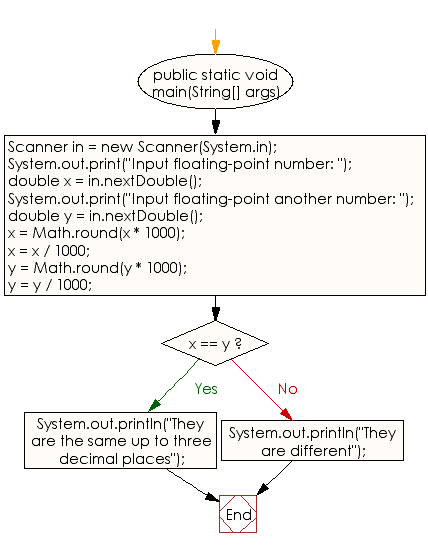Java: Test two floating-point numbers are same upto three decimal places
Compare Floats Up to Three Decimals
Write a Java program that reads two floating-point numbers and tests whether they are the same up to three decimal places.
Test Data
Input floating-point number: 25.586
Input floating-point another number: 25.589
Sample Solution:
Java Code:
import java.util.Scanner;
public class Exercise6 {
public static void main(String[] args)
{
Scanner in = new Scanner(System.in);
System.out.print("Input floating-point number: ");
double x = in.nextDouble();
System.out.print("Input floating-point another number: ");
double y = in.nextDouble();
x = Math.round(x * 1000);
x = x / 1000;
y = Math.round(y * 1000);
y = y / 1000;
if (x == y)
{
System.out.println("They are the same up to three decimal places");
}
else
{
System.out.println("They are different");
}
}
}
Sample Output:
Input floating-point number: 25.586 Input floating-point another number: 25.589 They are different
Flowchart:

For more Practice: Solve these Related Problems:
- Write a Java program to compare two float values for equality up to three decimal places using BigDecimal.
- Write a Java program to truncate two floating-point numbers to three decimals and then compare them for equality.
- Write a Java program to check near-equality of floats using an epsilon value of 0.001 and output a detailed message.
- Write a Java program to compare two floats by formatting them with String.format("%.3f") before the comparison.
Go to:
PREV : Weekday Name from Number.
NEXT : Days in a Month.
Java Code Editor:
Contribute your code and comments through Disqus.
What is the difficulty level of this exercise?
Test your Programming skills with w3resource's quiz.
